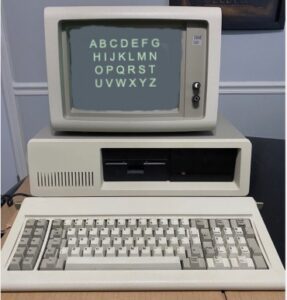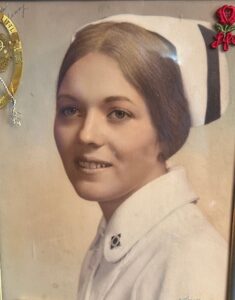

Mary’s Story 1984: The Dawn of Augmentative Communication
Introduction
In the heart of the 1980s, a unique case crossed my desk at Christ Hospital in Jersey City. It was July 1984, a time when home computers were just emerging. This story recounts my decade-long relationship with Mary Solares and her triumph using augmentative communication to overcome a debilitating disease.
Meeting Mary: Understanding the Challenge
Mary was a dedicated pediatric nurse when she was diagnosed with Multiple Sclerosis (MS). Her husband, Henry, often spoke about her love for working with children. Unlike today, where MS can be managed with disease-modifying therapies, advanced symptom management, and improved rehabilitation strategies, Mary faced a rapid onset of the disease. Within a short period, she began using a wheelchair at the age of 39.
Initial Assessment
Though my caseload was limited to Jersey City, Mary’s case reached me in early summer of ’84 due to my prior experience with switch-operated devices. Upon entering her home, I was greeted by Carmen, Henry’s mother and now Mary’s primary caretaker. Mary welcomed me warmly, despite her physical limitations.
During the assessment, I observed that Mary could produce sounds, but her speech was no longer intelligible. Using head gestures, eye contact, and speech sounds, Mary could respond with yes or no to my questions and even laugh at some of my comments. I considered sign language, but Mary had very limited control of her hands and arms. Instead, I introduced a simple chin switch from my bag. Mary could consistently activate the switch by moving the right side of her head. My assessment concluded that Mary had severe communication limitations, making her an ideal candidate for augmentative communication.
Challenges in Acquiring AAC Devices
In the early days of augmentative communication, obtaining approval for AAC devices was challenging, especially given Mary’s insurance limitations. In 1984, such devices were rare and prohibitively expensive, often costing thousands of dollars. Insurance coverage was minimal or non-existent, with most private insurance plans not covering AAC devices. Medicaid coverage for augmentative devices had not yet been established. These technologies were often classified as “experimental” or “educational” rather than medical necessities.
The Promise of Home Computers
During the summer of 1984, the first home computers by IBM were entering the market. At computer shows, enthusiasts could purchase individual parts like cases, motherboards, monitors, and speech synthesizers to build their own PCs. This emerging technology held promise for creating affordable augmentative communication solutions.
Collaborating with My Father
After meeting Mary, I spoke with my father, Jack Burke, a retired systems analyst and programmer. He was eager to help and immediately began creating an augmentative communication program designed specifically for her.
With my background in computer programming, I took on the task of assembling the necessary computer components. At a computer show, we acquired essential parts—a case, motherboard, monitor, speech synthesizer, and a small printer—for under $300, effectively creating an IBM XT equivalent. Combining my knowledge with my father’s computer skills, we built a communication device for Mary. This collaboration was a crucial step in developing an affordable and effective solution using emerging home computer technology.
The Device Design
The device we created featured a simple yet effective design. It had four rows of letters, and Mary could select a row and then a specific letter as it was highlighted. A speech synthesizer articulated the chosen rows and letters, allowing Mary to communicate fluently. Interaction with the system was facilitated by a chin-operated switch, enabling her to navigate the device independently.
The Moment of Truth
After about a month of programming, the system was ready. Despite a hectic personal period with the birth of my son, I managed to set up the device at Mary’s home. I provided a brief explanation of its operation and promised to return for more detailed training.
Mary’s First Letter
Five days later, I received a letter addressed to me from Kearny. Surprised to see a letter from Mary, I opened it with excitement. Mary, who had previously been limited to basic yes/no responses, was now communicating fluently through her typed words. Her intelligence and quick learning were evident as she expressed her gratitude and shared her thoughts.
The Letter:
DEAR JOHN AND MARY,
FIRST OF ALL, I WANT TO CONGRATULATE YOU ON THE BIRTH OF YOUR SON JOSHUA.
MARY, IF YOU COULD HAVE SEEN THE LOOK ON YOUR HUSBAND’S FACE, WHEN HE CAME TO THE HOUSE THAT DAY, I BELIEVE YOU WERE STILL IN THE HOSPITAL. I’VE SEEN THAT LOOK ON MY OWN HUSBAND’S FACE.
I WANT TO TAKE THIS OPPORTUNITY TO TELL YOU HOW MUCH I REALLY APPRECIATE ALL YOUR LONG HOURS OF HARD WORK AND DEDICATED DEVOTION TOGETHER WITH YOUR FATHER. MY THANKFULNESS MAY NOT BE CLEAR, AS THIS IS MY MAIN COMMUNICATION METHOD.
DESPITE YOUR ADVICE NOT TO DEPEND ON IT, IT’S CHALLENGING FOR MY FAMILY TOO. WITHOUT IT, EVEN WRITING A RADIO BROADCAST ABOUT YOU WOULD BE IMPOSSIBLE. YOUR DEDICATION IN HELPING SO MANY PEOPLE DESERVES ACCREDITATION SOMEHOW. THANKS TO YOU, I CAN WRITE SO MANY LETTERS NOW.
WISHING YOU AND YOUR FAMILY MUCH HEALTH AND HAPPINESS. GOD BLESS.
P.S. JOSHUA IS A VERY SPECIAL BABY BECAUSE HE WAS BORN ON MY BIRTHDAY, SEPTEMBER 17TH.
See the actual letter here.
The Impact of Assistive Communication
For the next ten years until her passing, Mary used her assistive communication as her primary means of expression. She wrote heartfelt letters to friends and family, helped her children with homework, and even gave radio interviews about her experience. Augmentative communication restored Mary’s voice, allowing her to connect meaningfully with family and loved ones.
A Milestone in My Career and a Communication Aid Success
This experience marked a significant chapter in both Mary’s life and my career as a speech therapist. It demonstrated how individuals with severe communication limitations could gain a vital means of expression through technology. This innovation added a new dimension to speech therapy, marking an exciting time for both therapists and clients.
Continued Improvements
Over the next couple of years, leveraging my programming expertise, Mary’s program was updated to include word prediction and environmental control for her lighting and TV. The device operated continuously for nearly ten years, enabling Mary to focus on raising her five children.
A Profound Experience
One visit remains vivid in my memory. Mary pointed to the corner ceiling, indicating she felt she had left her body and was viewing herself from above the room. She expressed that it was not yet time for her to leave and returned. She described this as a beautiful religious experience that deepened her faith.
Final Moments: Reflecting on an Assistive Communication Achievement
Years later, Mary’s family called to inform me that her condition had worsened, and she was hospitalized. They requested that I set up her device in her hospital room. Upon entering, I found Mary in a deep sleep as I began setting up her device next to her bed. The room was quiet, with a radio playing music softly.
A Poignant Farewell
As I neared the end of the setup, a song by the Commodores started playing with lyrics that seemed to express gratitude for memories shared. “Thanks for the times that you’ve given me. The memories are all in my mind.” In that moment, I sensed that Mary, despite her condition, had somehow found a way to express her appreciation for my time and service.
Mary passed that evening, but her memory—as patient and person—will remain with me forever.
Conclusion
Mary’s story is a testament to the power of augmentative communication and its profound impact on an individual’s life. Her journey highlights the importance of innovation in speech therapy and the incredible potential of technology to give a voice to those in need. This experience was a significant milestone in my career and serves as a constant reminder of the difference that assistive communication can make.
